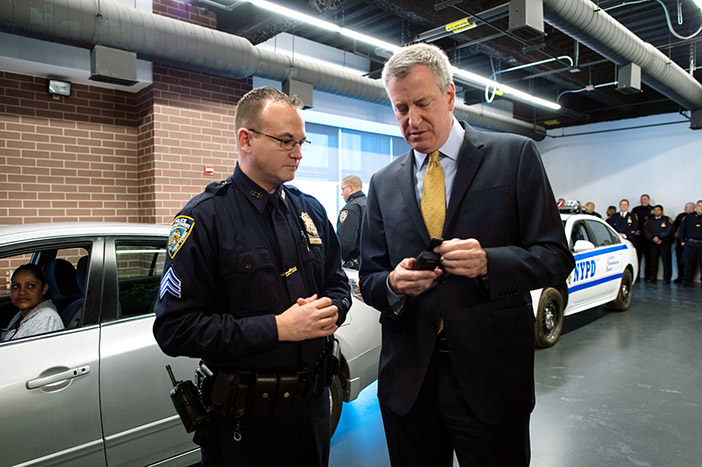Photo Courtesy of Rob Bennett/Mayoral Photography Office
The updated procedure has been submitted to the NYPD federal monitor for his review and approval.
By Michael V. Cusenza
The City Police Department last week announced the release of its proposed police officer body-worn camera procedure.
According to the NYPD, the 53-page report detailing the updated procedure, “NYPD Response to Public and Officer Input on the Department’s Proposed Body-Worn Camera Policy,” the proposal “ensures officers participating in the body-worn camera pilot program capture objective records of encounters, while encouraging lawful and respectful interactions between the public and the police.”
The department also noted that the body-worn camera procedure is the culmination of a yearlong outreach effort that included key stakeholders and advocates, including: the NYPD Inspector General, the NYC’s respective district attorneys, members of the City Council, Public Advocate, New York Civil Liberties Union, Civilian Complaint Review Board, Patrolman’s Benevolent Association, Citizens Crime Commission, and more.
Provisions of the policy cover when and under what circumstances cameras should activated, how footage can be viewed, retention of footage, and the release of footage to the public:
Activation of cameras: Mandatory activation during all enforcement and investigative encounters. Mandatory deactivation during interactions with confidential informants or sex crime victims, as well as internal meetings and training.
Viewing of footage: An officer may view his or her own, and other officers’ BWC footage in the furtherance of official duties (arrest processing, etc.). During an official department investigation, including serious injury or death of a person, or an officer firearms discharge, the officer concerned may view his or her own BWC recordings at a time deemed appropriate by the supervisor in charge of the investigation before being required a compelled statement.
Retention of footage: Body camera footage will be retained for one year (and can be retained longer on a case by case basis)
Release of footage: The procedure will also cover how and when footage is released to prosecutors, during litigation, and to the public.
Additionally, last summer, the NYPD indicated that it wanted input on its body camera policy from the communities it patrols. So, in partnership with the Policing Project at NYU School of Law, the department sought to cull perspectives of people who live, work, or go to school in the Big Apple through an online questionnaire. New York University collected the responses and comments and provided them to the NYPD for the department’s consideration in drafting the final policy.
At the same time, the Marron Institute of Urban Management at NYU launched a separate but similar online questionnaire to get input from police officers. The surveys remained open for 40 days.
“Our academic partners provided invaluable guidance on crafting questionnaires, made exhaustive efforts to promote the questionnaires to achieve maximum participation, and did an extraordinary job of organizing the questionnaire results and summarizing participants’ open written comments in two comprehensive reports,” the NYPD said. “We are grateful for their exceptional work and for the time officers and members of the public spent completing the questionnaires and providing comments.”
The department noted that the questionnaires indicated that both the public and cops support a BWC program.
“Not only will body-worn cameras enhance transparency and accountability, they will further improve the trust that continues to grow in these relationships,” added Police Commissioner Jim O’Neill.

